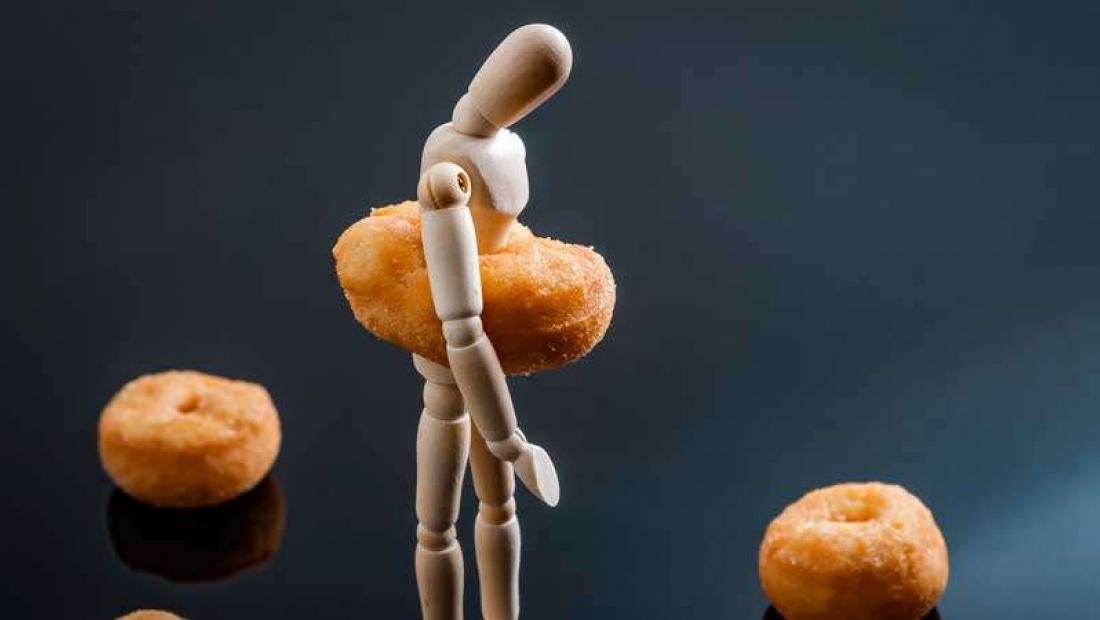
Summer is quickly approaching and you know what that means? Dun, dun duuunnnn! Swimsuit season! It’ll be here before you know it. But, according to ABC News’ nutrition and wellness editor David Zinczenko, all you need is 14 days -- just 14 days to make positive changes to your body.
His latest book, Zero Sugar Diet: The 14 Day Plan to Flatten Your Belly, Crush Cravings and Help Keep You Lean for Life can help you go from flab to fab fast. Here’s an exclusive sneak peek of the first chapter!

Chapter 1: Strip Away Sugar, Strip Away Trouble
Fourteen days.
That’s all it will take to change your body. So, it’s no wonder that when I announced a test program for The Sugar Swap Diet, more than eleven hundred signed up in twenty-four hours. As soon as the word went out among the five million people who visit EatThis.com every month, we began hearing from fans who were trying to control their sugar addictions but struggling each and every day.
Our test panelists not only lived The Sugar Swap Diet, but they documented -- on a day-by-day basis -- the remarkable changes that happened within their own bodies. Energy levels soared. Waistlines shrank. Blood pressure and cholesterol numbers plummeted. Muscles became toned and lean.
This unique day-by-day approach will help to keep you motivated as you compare yourself with, and even exceed, the success of the test panelists, many of whom struggled with real sugar addictions. When you reduce your sugar intake using this program, while slowing its impact on your body, a number of amazing things will happen, with shocking rapidity:
1. You’ll Start Burning Fat
Immediately. Reducing your intake of calorie-dense sugar carbs automatically reduces the amount of calories you’re consuming on a daily basis, which forces your body to burn fat stored around your midsection for energy, rather than the sugars it takes from carbohydrates.
2. You’ll Feel Less Hungry
As your body detects that you’ve started to lose weight, your hunger hormones get furious. They start firing off signals to your brain telling you that winter’s approaching, the barbarian hordes are at the gate, and you’d better consume every calorie in sight in order to prepare for the famine ahead.
This plan uses the power of fiber to counteract that basic instinct. By slowing the progress of carbohydrates through your body, fiber helps give you a continuous, steady dose of energy, so you never get the “I’m empty” signal. Oh, you’ll eat plenty of food, but not because you’re ravenous. Because it tastes so good!
3. Your Belly Will Get Flatter
One of the first things you notice when you replace simple carbs with high-fiber foods is that your belly begins to flatten out -- literally within days. The reason: Most Americans only take in 15 of the recommended 25 to 38 grams per day, according to the Institute of Medicine. As a result, the healthy gut microbes that keep us lean have less to munch on, and the unhealthy microbes -- which feast on sugar-- take over. Those are the little buggers that cause bloating and make your belly look bigger than it actually is. In fact, an increase in the “bad” belly biome bacteria -- a family called Firmicutes -- is one of the most noticeable differences between Americans in the lean 1980s and those in the fat 2000s. I’ll show you how this plan changes the way your gut acts and feels, and why fourteen days is all it takes to shrink your waist size by as much as seven inches.
4. You’ll Slash Your Risk of Diabetes
Eating too many simple sugars can wreak havoc in your body in both the short and long term. The more of these quickly digested carbs you consume, the more insulin your pancreas produces, eventually leading to insulin resistance and possibly type 2 diabetes.
5. Your Muscles Will Get Stronger
In one of the most stunning studies of recent years, scientists have linked refined sugar to a condition called sarcopenia -- basically, age-related loss of muscle mass. It happens because added sugar actually blocks the body’s ability to synthesize protein into muscle. (Spending big bucks on protein supplements? If they have added sugar, they’re probably hurting, not enhancing, your ability to build lean muscle.) By reducing the impact of sugar, this plan will keep your muscles younger and stronger -- protecting you from injury and helping you to burn fat faster and more efficiently.
6. You’ll Feel More Energized
By slowing your body’s absorption of carbohydrates, you’ll keep your body and your brain more fully fueled all the time, beating both general physical fatigue and the brain fog that can often accompany it. You’ll no longer need to make poor food choices as a way of getting quick energy, and you won’t be dragging through those afternoon hours.
Raising (Sugar) Cain
You can see why I had to write this book.
In fact, for the past two decades, I have been investigating the secrets of the food industry. And I’ve gotten tired of marketers trying to blame us, the American people, for the obesity crisis. In 2002, I published a controversial New York Times op-ed in defense of a group of kids who were suing McDonald’s for making them fat.
A lot of people thought I was nuts: Suing McDonald’s for making you fat is like suing Porsche for making you get a speeding ticket. But at least that Porsche comes with a speedometer. Fifteen years ago the idea of there being calorie counts and nutrition information for restaurant food was unheard of. There was absolutely no way of knowing how many calories were in that Big Mac. And, as I pointed out, if you drive down any highway in America, it’s a lot easier to find a set of golden arches than it is a place to buy a grapefruit.
That op-ed was the opening salvo in what has become a career-long crusade. When I wrote The Abs Diet in 2004, I dedicated it to “every American who has taken up arms in the battle against obesity.” I explained why counting calories while you diet and exercise wasn’t the way to lose weight: Simply put, it takes far too long to burn off 300 calories, and no time at all to eat them back up. Instead, I focused on quality nutrition and the importance of boosting metabolism -- long before “boost your metabolism” became a catchphrase.
But it wasn’t until I launched Eat This, Not That! in 2007 that real change began to happen. The first of nearly twenty books in the Eat This, Not That! franchise said it all in the dedication, when my co-author Matt Goulding and I called out Applebee’s, Olive Garden, Outback, Red Lobster, and T.G.I. Friday’s for concealing their nutritional information. (Today, each and every one provides full nutritional data for all their offerings.)
At first, food manufacturers hated me. But soon, they began to change their tune. When we ran a blog in 2008 exposing Baskin-Robbins for producing a 2,310-calorie Heath Bar milkshake, the company followed up by scrapping the drink, as well as its entire line of “premium” shakes. Jamba Juice unveiled a line of high-fructose corn syrup–free drinks in 2009, and CEO James White cited Eat This, Not That! as the inspiration for the move. A few months later, Gatorade and Hunt’s took steps to reduce HFCS and, by the end of that year, HFCS consumption in the United States began to drop for the first time in thirty years.
Few movements have changed the way we eat more than Eat This, Not That! From the world of nutritional mystery I first wrote about in 2002, we emerged in 2015 to a new day, when the FDA at last required calorie counts to be displayed in all chain restaurants and -movie theaters -- long after most restaurants, under pressure from ticked-off consumers, had already made the move voluntarily.
But knowing what you’re eating is only part of the battle. How and when to eat is also important. I wrote The 8-Hour Diet in 2012 in response to shocking new research about longevity and how the timing of our meals could dramatically extend our lives, flatten our bellies, and reduce our risk of diabetes. And in 2013, I began tracking breakthrough research emerging out of Europe about nutrigenics -- the study of how our genes interact with our food in ways that determine whether or not our fat genes get triggered.
The book that resulted from that research, Zero Belly Diet, became one of the biggest books of 2015, and it solved for me one of the great personal mysteries of my life -- why my brother Eric was a star athlete in high school, while I was a flailing firkin of flab. It turns out that, like Eric and me, most of us carry the fat genes, but it’s only when we eat too much of the wrong food, and too little of the right food, that those genes wake up and cause us to begin storing more fat than we want to. His healthy eating habits didn’t trigger his obesity storage genes; my diet of Cheetos and Cheez Whiz did.
But Zero Belly Diet opened my eyes to new science that demanded further exploration. One of those breaking areas of research was the role that fiber had in feeding our gut biomes -- the complex systems of bacteria that live in our digestive organs and do much more than just break down food. They play an essential role in managing our hormones, our energy levels, and even our immune systems. A balanced gut means physical and emotional health, as well as a properly calibrated sequence of genes that are firing the way nature intended. Feed the good bacteria, and you lose weight. Feed the bad, and you gain.
And guess what the bad bacteria love to eat? Sugar.
Excerpted from Zero Sugar Diet by David Zinczenko with Stephen Perrine; Copyright © 2016 by David Zinczenko. Excerpted with permission from Ballantine Books. All rights reserved. No part of this excerpt may be reproduced or reprinted without permission in writing from the publisher.
MORE:
Men's Health's David Zinczenko
4 Delicious New Health Food Trends You’ll Want to Gobble Up


